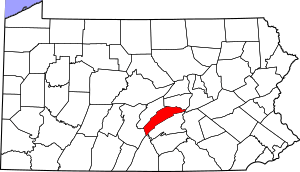List of Pennsylvania state historical markers in Juniata County facts for kids
Have you ever seen a special sign by the road or in a town that tells you about something important that happened there a long time ago? These signs are called historical markers. They help us learn about the past and remember important people, places, or events.
In Juniata County, Pennsylvania, there are five official state historical markers. These markers were put up by the Pennsylvania Historical and Museum Commission (PHMC). The PHMC is a group that helps protect and share Pennsylvania's history. Each marker tells a unique story about Juniata County's past, from old forts to important trails and schools. Let's explore what these markers teach us!
Exploring Juniata County's History Through Markers
Juniata County is full of interesting history, and these markers help us discover it. Each one tells a piece of the story, showing us how people lived, fought, and learned many years ago.
Fort Bigham: A Frontier Outpost
One of the markers tells us about Fort Bigham. This fort was built a very long time ago, in 1747, by a man named Samuel Bigham. It was a private fort, meaning it wasn't built by the government, but by settlers to protect themselves. During the French and Indian War (which happened between 1754 and 1763), this area was the edge of the frontier. Settlers often faced dangers from Native American raids.
Sadly, in 1756, Fort Bigham was attacked and destroyed. Many people were killed or captured. This marker reminds us of the brave people who lived on the frontier and the challenges they faced to build new lives. You can find this marker northwest of Mexico, Pennsylvania.
Juniata County: A Place of Growth
Another marker celebrates Juniata County itself! This county was officially created on March 2, 1831. It was formed from parts of Mifflin County. The marker is located at the County Courthouse in Mifflintown, which is the county seat.
This marker helps us remember how Juniata County grew and developed over time. It also touches on how important transportation was for the county's growth, as roads and waterways helped people and goods move around.
Patterson's Fort: Another Frontier Stronghold
Close by, you'll find a marker for Patterson's Fort. This fort was also built during the French and Indian War, around 1751, by Captain James Patterson. Like Fort Bigham, it was a place where settlers could seek safety from attacks.
The fort played an important role in protecting the early settlers in the Juniata Valley. It reminds us of the difficult times and the need for protection on the frontier. This marker is located near Mexico, Pennsylvania.
Tuscarora Academy: A Place of Learning
The Tuscarora Academy marker points to a very important school from the past. This academy was founded in 1836 and was a famous school in the region for many years. It was one of the first schools in the area to offer higher education, teaching subjects like math, science, and classical languages.
The academy was also known for its strong connection to religion and moral education. It helped shape many young minds in the 19th century. The marker is located right at the site of the former academy in Academia, Pennsylvania.
Tuscarora Path: An Ancient Trail
Finally, there's a marker for the Tuscarora Path. This wasn't a road built by settlers, but an ancient trail used by Native Americans for hundreds of years. It was a major pathway that connected different Native American villages and hunting grounds.
The path was named after the Tuscarora people, a Native American tribe. Later, European settlers also used parts of this path as they moved into the area. This marker helps us remember the long history of the land and the people who lived here before us. You can find this marker northwest of Mexico, Pennsylvania.
Images for kids
Want to Learn More?
- List of Pennsylvania state historical markers
- National Register of Historic Places listings in Juniata County, Pennsylvania



